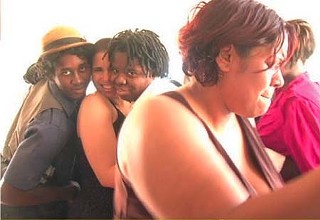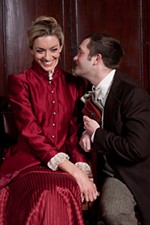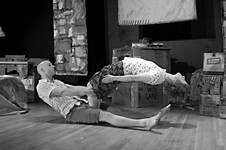love conjure/blues
Sharon Bridgforth's love/conjure blues is a ritual steeped in the magic of the Southern black oral tradition and West African spirituality but encircling all of us
Reviewed by Abe Louise Young, Fri., June 22, 2007
love conjure/blues
The Off Center, through June 23
Running time: 1 hr, 30 min
Love: An indefinable, essential, infinite human/divine resource
Conjure: To summon into action or bring into existence, often as if by magic; "she conjured wild birds in the air"; "he conjured spirits from the mountain"
Blues: A 20th century vocal and instrumental musical form, which evolved from African-American spirituals, work songs, and chants, with stylistic roots in West Africa
Sharon Bridgforth's love/conjure blues is a ritual. Magic is an active verb here: Audience members witness the raising of a full community of characters from memory, imagination, and the dead. Bridgforth's signature style weaves the Southern black oral tradition and West African spirituality together and saturates this braid with queer characters. We meet "the mens and the womens, the boths and the neithers." As in any ritual, it's hard to describe later what happened: Time shifts into a spiral.
Bridgforth is well known as a performance poet who brings many voices alive at once. love conjure/blues (RedBone Press, 2004) is a performance/novel, written to be heard out loud. In this production, however, Bridgforth's work is brought to a new level of realization by an ambitious collaboration with filmmaker Jen Simmons and a large cast of actors. Bridgforth – the only live performer – moves through the space, sometimes narrating, sometimes not, while a multimedia visual-art installation moves on three large screens. The characters dance, mime, and act, wordlessly telling the stories of Figua's Flavas, a down-home juke joint that exists in "the past, the present, and the future."
Figua's Flavas is so packed with personalities that the walls shake. On buffet night at the juke joint, Ducky Smooth is the meal: He does multiple female interpretations with costumes sewn by his wife, Cora Adams. (She color-coordinates her outfits to his and collects "appreciation fees.") One drama-high evening, Fathead Sims and Ducky Smooth roll out onto the stage fighting, and by the end, Ducky's "wig was off, his face-cake was caked, his titties was crooked, and his panties was showing just as pink as you please." Sultry, sexy Change comes in near the end of the show, stirring up trouble and reuniting old lovers. These are Southern stories drenched in the blues: love story and catastrophe expressed lyrically.
Bridgforth and Simmons connect this community to a larger history of racial struggle in the United States through video. One particularly affecting montage shows black-and-white footage of civil rights protesters in the 1950s; we feel their hope and fury, then see them beaten by police. This creates a haunting awareness of how time is layered: the past lives in our memories and bodies. We carry experience in our cells.
Moving through different eras of history, the narrator tells of her grandfather's spirit broken by the threat of lynching. Further back in time, we hear of an enslaved drummer whose fingers are cut off by his white owners, then displayed in a jar on the counter as a warning to other slaves. For every drop into despair, however, Bridgforth's stories build a ladder to spiritual redemption. The drummer begins to drum with his feet, creating a dust cloud so potent and supernatural that his attackers are frightened and can come no closer. The video art modulates the rhythm and intensity of the narrative with soothing scenes of water, trees, and clouds, reminding us that the Earth's healing power is ever-present.
When Bridgforth passes baskets through the audience with a folded love note for each person, you realize you have been part of the ritual all along. Once you stepped over the circle of salt, sand, and tiny gems that encircles the stage space to find your seat in the center, you were part of this story: finding love in the cracks, refusing to be beaten, coming together to cry, laugh, and – at the climax – rising from your seat with the folks of Figua's Flavas and the other bodies in the room, to dance.










